Written by: Will A-Wang
Consumer habits in cross-border payments are constantly changing: people are trying various payment methods while still searching for better options. As VISA's Ryan McInerney stated, "The changes in payment methods over the past five years have been greater than those in the past fifty years."
Today, with the continuous development of blockchain technology and digital currencies, the deeper change behind the evolution of payment methods is actually a change in accounting methods—the blockchain, a public and transparent global ledger.
The way humans have kept accounts has only changed three times in thousands of years, each time profoundly shaping economic forms and social structures. Each breakthrough reflects the co-evolution of technology and civilization.
- The single-entry bookkeeping of the Sumerian period allowed humanity to break through the limitations of oral communication for the first time, facilitating early trade and the formation of nations;
- Double-entry bookkeeping played a role in the commercial revolution of the Renaissance, leading to the emergence of banks and multinational companies, and the establishment of commercial credit;
- The distributed ledger driven by Bitcoin in 2009 has facilitated decentralized finance, changes in trust mechanisms, and the rise of digital currencies.
This far-reaching transformation will not happen overnight; it is continuously evolving and has currently led to Web3 payments based on blockchain and digital currencies, a new payment method that is increasingly penetrating various aspects of real society.
Thus, this article leverages VISA's recent consumer cross-border payment survey report and presents solutions for Web3 payments in the main scenarios of current consumer cross-border payments through market cases, ultimately looking at where the future of Web3 payments lies.
The full text is 15,000 words; enjoy the following:
I. The Growing Cross-Border Payment Market
Driven by the surge in cross-border e-commerce, cross-border travel, and cross-border remittances, the cross-border payment market is experiencing explosive growth. Consumers are engaging in cross-border payments more frequently than ever, with the Bank of England predicting that related payments will reach $250 trillion by 2027.
Consumers around the world are embracing cross-border payments, with spending on cross-border transactions higher than ever. However, what is truly interesting is the frequency. 30% of people shop cross-border through e-commerce weekly, 45% send and receive remittances monthly, and 66% travel abroad annually.
Typically, people develop habits that make routine decisions easier and more efficient, but in the field of cross-border payments, such habits have yet to be established. On average, they use four out of seven different payment methods, while only 16% of consumers consistently use their default payment method.
Currently, it seems that no single payment method can fully meet consumers' needs for cross-border payments, although nearly 80% of consumers still use traditional banks for cross-border payments. However, one clear point for consumers is that they need a secure and trustworthy cross-border payment provider.
From June 2023 to June 2024, a total of 771 million people engaged in cross-border transactions. VISA's research indicates that this growth is driven by three transaction categories: e-commerce, travel, and remittances.
1.1 Main Scenarios and Methods
A. Cross-Border E-Commerce
Eighty percent of consumers choose to shop through cross-border e-commerce, with 67% making cross-border purchases monthly. According to the "2024 Global Trends in B2C E-Commerce and Online Payment Innovation" report, the global B2C e-commerce market is expected to exceed $8.3 trillion by 2026. Today, finding desired products globally is no longer a challenge, but the convenient payment experience still needs improvement. Consumers crave simple, easy-to-use, and secure payment methods to complete each cross-border shopping experience smoothly.
B. Cross-Border Travel
Two out of three people have cross-border travel experiences, with 52% traveling more than once a year. According to the 2024 travel trends, the primary purpose of travel is to relax and relieve stress. Therefore, the last thing travelers want is the pressure or worry of shopping. They need a simple and secure payment method to fully enjoy their travels.
C. Cross-Border Remittances
Four out of ten people use cross-border remittance services, with 45% making remittance transactions monthly. Despite the complex geopolitical situation, the number of international migrants continues to grow, and it is expected that by 2028, the cross-border remittance market will exceed $1 trillion. This trend is also driving the increasing demand for remittances to domestic friends and family. Consumers urgently need a safe and reliable cross-border remittance method.

(Unlock the opportunity in cross-border payments, VISA)
Among the following seven cross-border payment methods, the average consumer uses four:
- Electronic payment methods;
- Credit or debit cards;
- P2P transfers;
- Bank remittances;
- Online transfers;
- Prepaid travel checks/cards;
- Cash.
1.2 Why Now is the Right Time to Offer Cross-Border Services to Consumers
The cross-border transaction market is vast and continuously growing. This is a critical stage in the development of cross-border transactions. More and more consumers are frequently engaging in cross-border payments, but traditionally, these transactions are often slow, costly, and lack transparency. However, all of this can change.
Consumers are currently using multiple payment methods. Each consumer is trying various payment solutions, actively seeking the one that suits them best. However, they have yet to find the ideal solution. They desire more choices and hope for guidance to help them make informed decisions. As consumers begin to form habits that may last a lifetime, now is a crucial moment to influence their choices.
Consumers need stable payment habits and reliable partners. As banks and fintech companies recognize the potential to become consumers' preferred cross-border payment methods, market competition will intensify. This is not only an opportunity to attract new customers through new services but also a chance to retain existing customers for cross-border consumption through one-stop solutions. However, there is also the risk of other competitors getting ahead.
The foundation of trust cannot be overlooked. In cross-border transactions, trust, security, and reliability are crucial, especially when transaction amounts are often large. Consumers are very sensitive to these factors and expect banks and fintech companies to provide a secure and reliable payment environment. Earning customer trust is key to establishing long-term partnerships.
II. Main Scenarios and Models of Consumer Cross-Border Payments
The following will delve into the process of payment transactions in cross-border e-commerce, cross-border travel, and cross-border remittances, as well as the core issues encountered in cross-border payments.
2.1 Cross-Border E-Commerce
In the past year, approximately 589 million people globally participated in cross-border e-commerce transactions. Among them, 72% of transactions were for physical goods purchased through mainstream online retailers like Amazon and eBay, while 44% were for digital products. Despite the rise of social media markets, only 30% of consumers shop through these platforms, which may be related to concerns about data breaches.
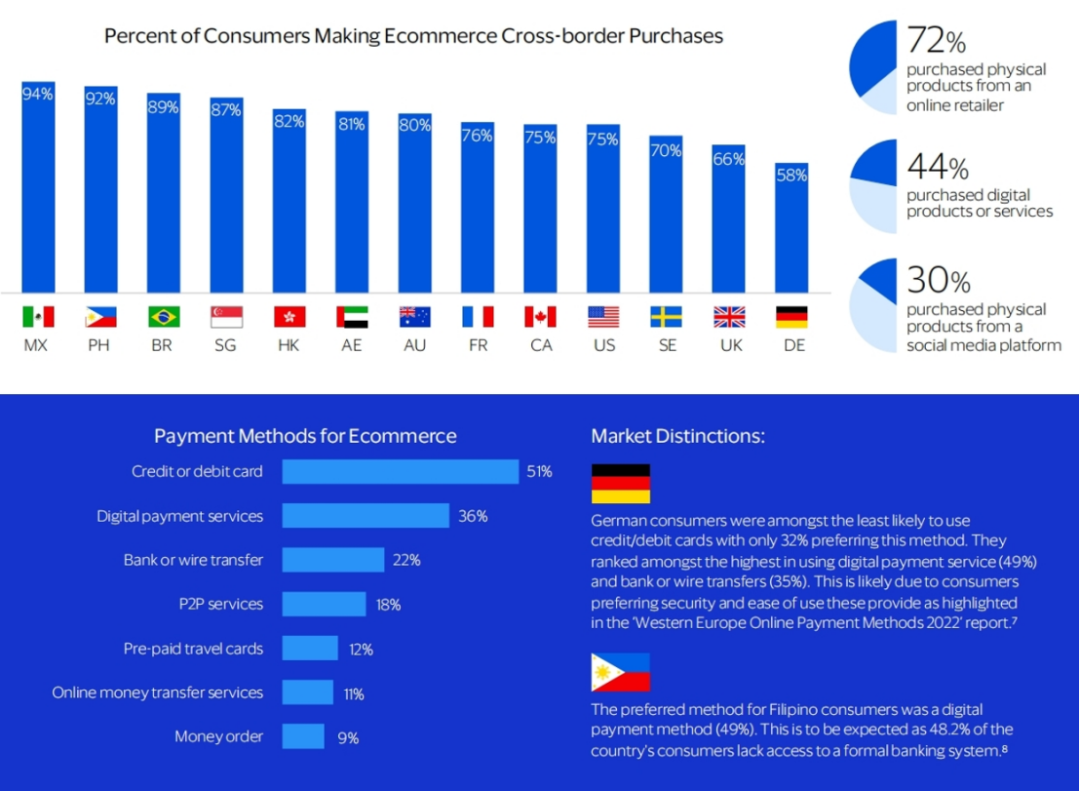
(Unlock the opportunity in cross-border payments, VISA)
In terms of payment methods for cross-border shopping, consumers mostly choose credit cards, debit cards, or digital app payment services (such as PayPal, Apple Pay). However, financial institutions may be surprised to find that only 51% of consumers use credit or debit cards. This indicates that there is still market space for other payment methods, such as 36% of consumers choosing digital app payment services, and some consumers using wire transfers or P2P services.
However, significant differences in consumer habits exist across different countries:
Germany: Consumers are least willing to use credit or debit cards (only 32%), preferring digital app payment services (49%) and bank transfers or wire transfers (35%). This may be because consumers place more importance on the security and ease of payment, as emphasized in the "2022 Western Europe Online Payment Methods" report.
Philippines: Consumers prefer digital app payment methods (49%), which may be related to 48.2% of local consumers lacking access to traditional banking systems.

(Convert more customers with the most relevant payment methods, Stripe)
The above image shows a comparison of payment habits among consumers in Germany, Malaysia, and the United States through Stripe's Payment Method dashboard. These data indicate that the choice of payment methods varies by region and consumer demand, and financial institutions and e-commerce platforms need to provide diverse payment solutions based on local market characteristics.
The payment scenario for cross-border e-commerce often involves consumers making purchases in their home country through the payment gateways of overseas e-commerce platforms. Payment gateways will inevitably link various payment methods, such as preferred credit or debit cards (through card organization networks), digital app payments like PayPal and Apple Pay, and bank transfers (through the bank's SWIFT network).
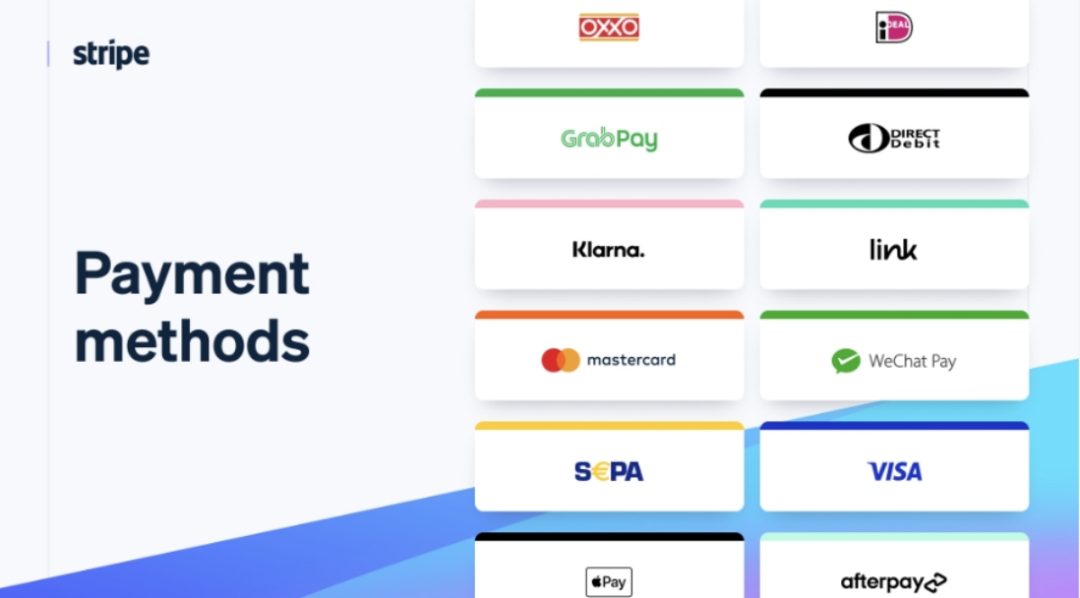
(Convert more customers with the most relevant payment methods, Stripe)
2.2 Cross-Border Travel
Among the surveyed consumers, two-thirds traveled abroad in the past year, with 62% indicating they used credit or debit cards to book travel, making it the most popular payment method. This preference is reflected not only in booking travel but also in their actual spending abroad. Most respondents used the same payment method during their travels as they did when booking. This may be because credit cards are widely accepted and offer conveniences such as instant currency conversion and fraud protection.
Despite the ongoing prominence of geopolitical factors, cross-border travel has become a norm, especially in Singapore (86%) and the UAE (84%), where consumers have the highest rates of traveling abroad. In the 13 markets surveyed, nearly 50% of respondents from each country traveled abroad in the past year.

(Unlock the opportunity in cross-border payments, VISA)
In terms of travel payment methods, consumers mostly choose credit or debit cards to book travel or pay for travel expenses. However, a small number of consumers also use other payment methods such as bank transfers, wire transfers, or digital app payment services.
Canadian travelers particularly favor credit or debit cards, with the proportion of those using other payment methods being less than 10% compared to other markets. This may be because Canadians place more importance on credit card reward systems; according to the "2024 Trends in Canadian Payments" report, consumers value reward points over transaction speed.
In contrast, Brazilian travelers are the least likely to use credit cards (below 50%), which may be related to Brazil's historically high credit card rates and the widespread adoption of PIX (an instant payment platform created by the Central Bank of Brazil).
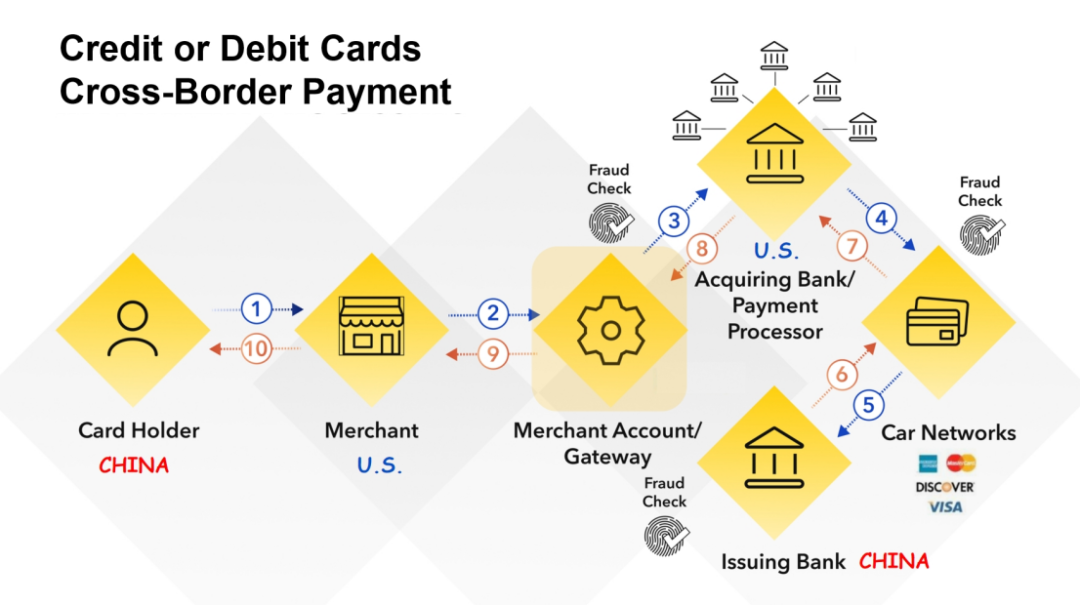
(Understanding Cross-Border Payments: Process, Challenges, and Solutions)
The payment scenario often involves consumers using their home country's debit or credit cards to make purchases at foreign merchants in person or scanning QR codes through digital app payment platforms. The above image illustrates the process of debit or credit card payments.
2.3 Cross-Border Remittances
In the past 12 months, 40% of respondents have sent or received remittances, with bank transfers or wire transfers being the most common payment methods. In countries with a large immigrant workforce, such as the UAE and the Philippines, the remittance send and receive ratio is the highest, at 87% and 74% respectively. This is not surprising, as remittances are a vital source of funds for millions of workers and families worldwide, and senders seek the most cost-effective payment services for each transaction.
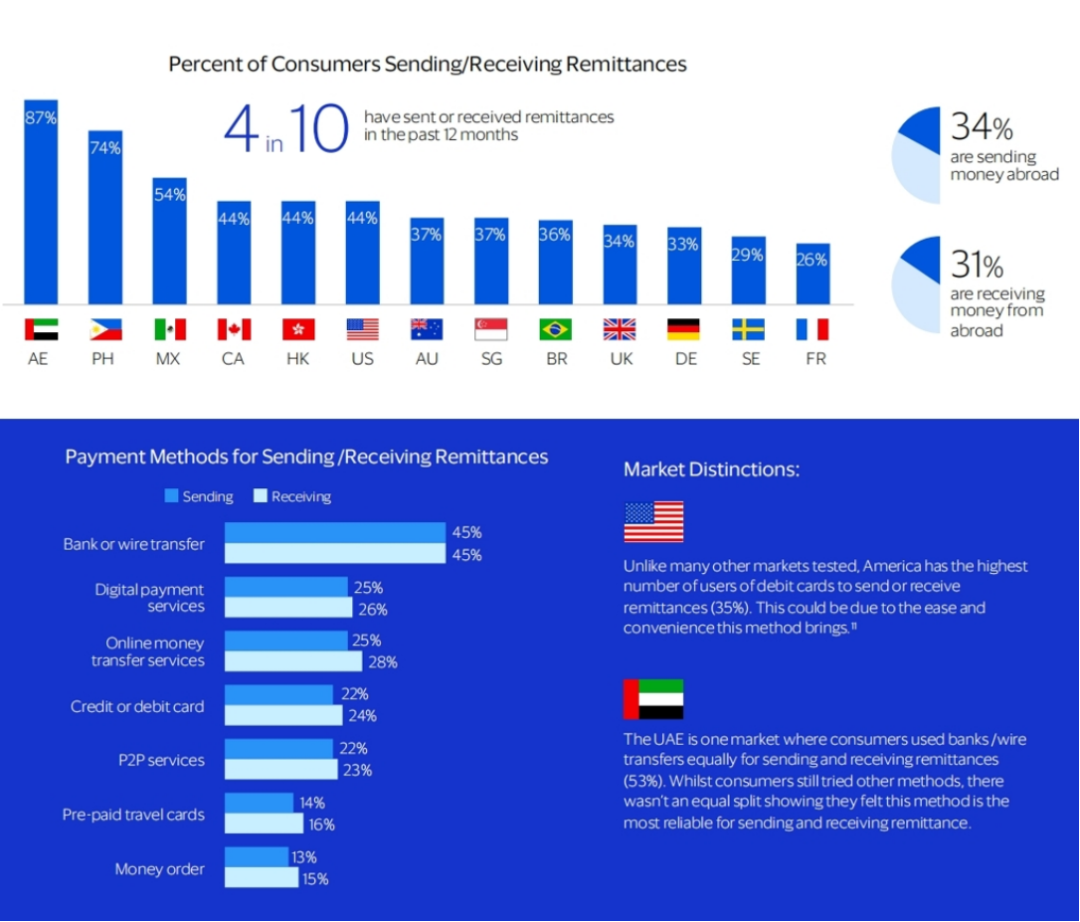
(Unlock the opportunity in cross-border payments, VISA)
In 2023, the total remittances flowing to low- and middle-income countries grew by 3.8%, reaching $669 billion. In the Asia-Pacific region, China, India, and Singapore are markets with frequent remittance activities. A notable trend is that digital app payments are increasingly favored by senders due to their security and ease of use, gradually becoming the primary method for sending and receiving remittances. Compared to traditional remittance methods, digital app payments are considered to be more secure.
There are significant differences between digital app payment methods and cross-border remittance payment methods. Although bank or wire transfer processing times are longer and costs are often higher, they remain the most commonly used remittance methods.
Unlike other markets, the United States has the highest proportion of users utilizing cross-border remittances (35%). This may be due to the convenience and ease of use of debit card payment methods. In the UAE, consumers use bank or wire transfers for cross-border remittances at an equal rate (53% each). Although consumers have also tried other payment methods, bank or wire transfers are the most reliable means for cross-border remittances.

(Cross-border payments, Bank of England)
The above is a flowchart of cross-border remittances through bank networks. If large banks in developed countries have settlement accounts with each other, the transaction process will be relatively simple. However, not every bank has a direct relationship, so sometimes they need to go through an intermediary—an "agent bank"—to conduct transactions. If there is no direct relationship between Bank A and Bank B, the agent bank will provide accounts for them.
For small currency/underbanked countries, the agent bank model (where intermediaries profit from the difference) can significantly erode their profits, placing a substantial burden on consumers. According to statistics from international banks, the average cost of remittances globally accounts for 6.62% of the remittance amount.
Research shows that consumers expect cross-border payments to be as convenient and smooth as everyday payments, and financial institutions must strive to meet this demand. Customers want cross-border payments to be fast, transparent, and efficient, with instant arrival, avoiding days of settlement waiting, especially for small transactions.
III. Characteristics and Pain Points of Cross-Border Payments
3.1 Cross-Border Payments Are Becoming More Common and Frequent
According to VISA's research, cross-border payments are quite common among many consumers in various regions. However, it may surprise many to learn how frequently these cross-border purchases occur. Although there are differences between different types of goods and markets, overall, a significant portion of consumers engage in cross-border payments monthly, weekly, or even more frequently.
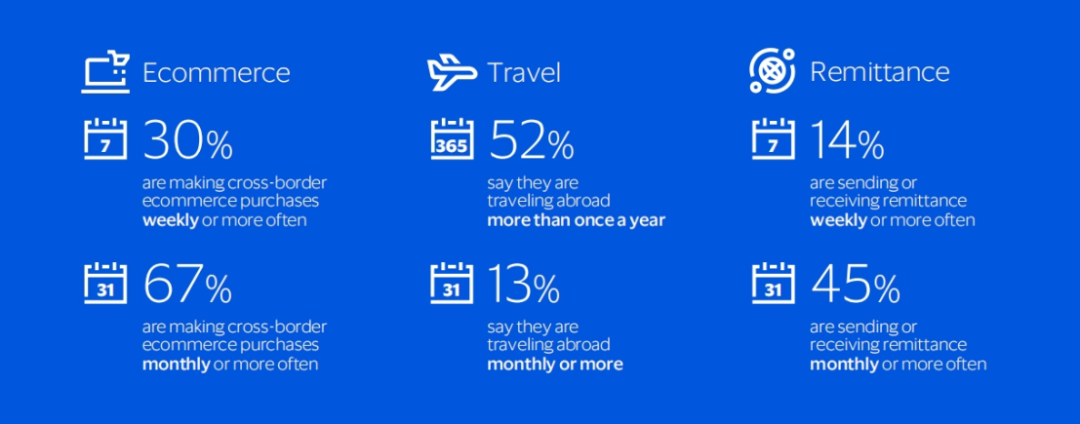
(Unlock the opportunity in cross-border payments, VISA)
Most digital natives—those who have grown up in a digital environment—such as Generation Z (84%) and Millennials (83%) have engaged in cross-border transactions in the past month, which is a considerable number. So what about the Baby Boomers and older generations? In fact, 68% of them reported that they had engaged in cross-border transactions in the past month, catching up—besides purchasing goods and services, they may also remit money to family abroad, pay tuition, or purchase real estate.
3.2 Payment Methods Are Not Fixed, and Habits Have Yet to Form
As cross-border payments become more common and frequent, understanding how consumers handle these transactions is crucial. VISA's research indicates that consumers currently have not formed clear preferences for payment methods in cross-border consumption and services. This presents a window of opportunity for fintech companies in cross-border payment services.
Currently, consumers still use a variety of different applications and payment methods when conducting cross-border transactions. In cross-border e-commerce and travel, over 50% of consumers use credit or debit cards through traditional banks for payments, which is clearly the most commonly used payment method, but not the only option. Similarly, digital app payment services are also quite popular, but other payment methods occupy a significant proportion of the remaining consumption.
In cross-border remittances, the types of payment chosen by consumers are more diverse. Bank transfers or wire transfer payment services are among the most widely used methods, but many consumers also use digital online transfer services, credit or debit cards, and P2P services.
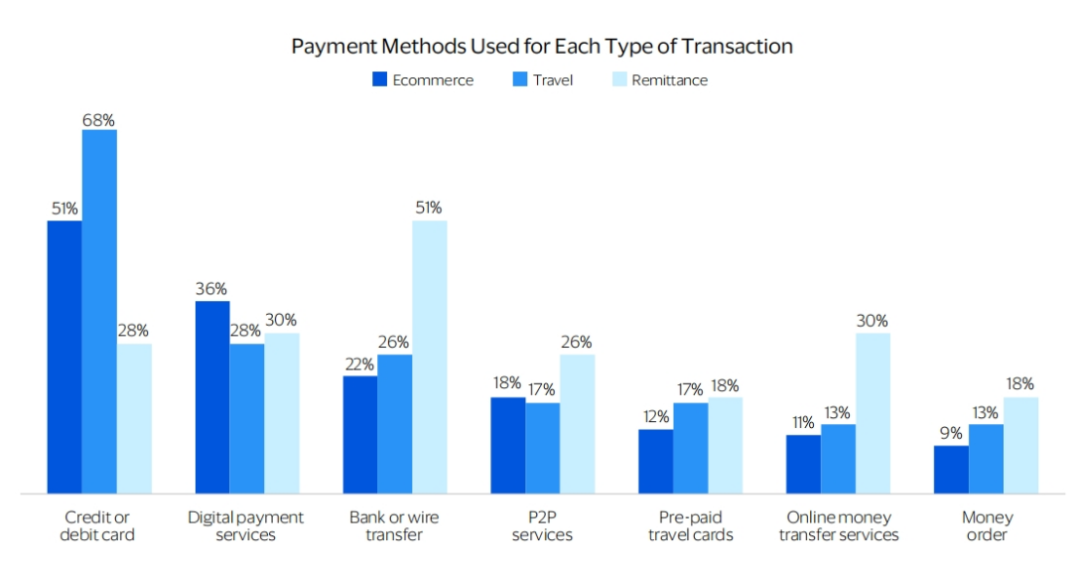
(Unlock the opportunity in cross-border payments, VISA)
3.3 Consumers Desire More Choices
VISA's research shows that in various regions, most consumers wish to have more choices in cross-border payments. A significant portion of consumers is dissatisfied with the current options available for cross-border transactions, with one in five consumers stating that the payment methods available to them for cross-border transactions are insufficient. In contrast, one in twelve consumers believes there are too many choices for cross-border transactions.
Consumers who engage in cross-border remittances particularly value having more options (76%). This demand is especially important among consumers in the Philippines (88%) and Mexico (82%), which are also labor-exporting countries with low local banking penetration.
It is worth noting that even in countries like Sweden (53%), the UK (53%), and France (52%), which already have a rich array of payment options, consumers express a desire for more choices, indicating that the cross-border payment market still has significant issues.
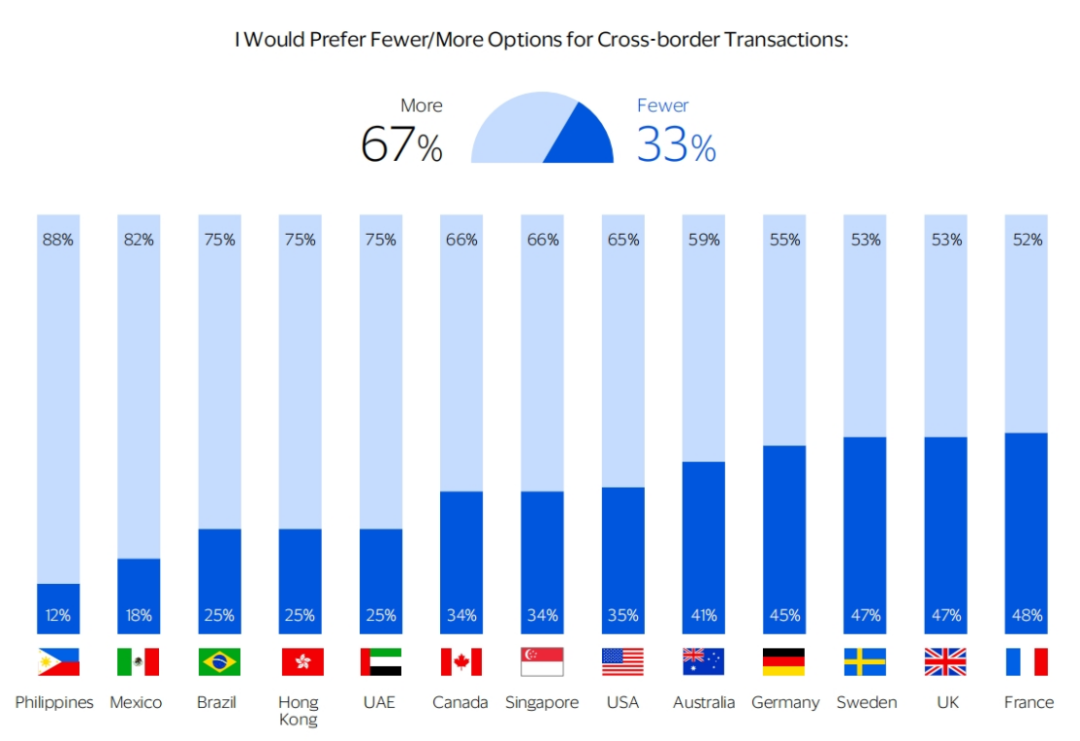
(Unlock the opportunity in cross-border payments, VISA)
More choices mean more intense competition, especially for banks and fintech companies. At the same time, this also indicates that the payment transaction experience is not entirely satisfactory; if consumers feel dissatisfied or need more options, they will not hesitate to turn to other service providers.
As a result, consumers tend to switch between multiple service providers. In key markets for cross-border payments, such as Sweden, Singapore, and the UAE, about half of the consumers participating in cross-border payments currently prefer to keep funds in multiple accounts to gain flexibility in fund transfers. This flexibility motivates banks and fintech companies to work harder to retain and attract customers by focusing on consumer behavior, attitudes, and needs, prompting them to implement the most suitable digital app payment methods for cross-border transactions.
However, such a multitude of choices, along with complex fee structures, often leaves consumers feeling overwhelmed. Therefore, when 71% of consumers express a desire for more guidance to better understand when and how to use different payment options, it is clearly a call to banks and fintech companies: there is a lack of guidance from trusted sources in the market. What they need is security, ease of use, clear guidance, and stable payment habits.
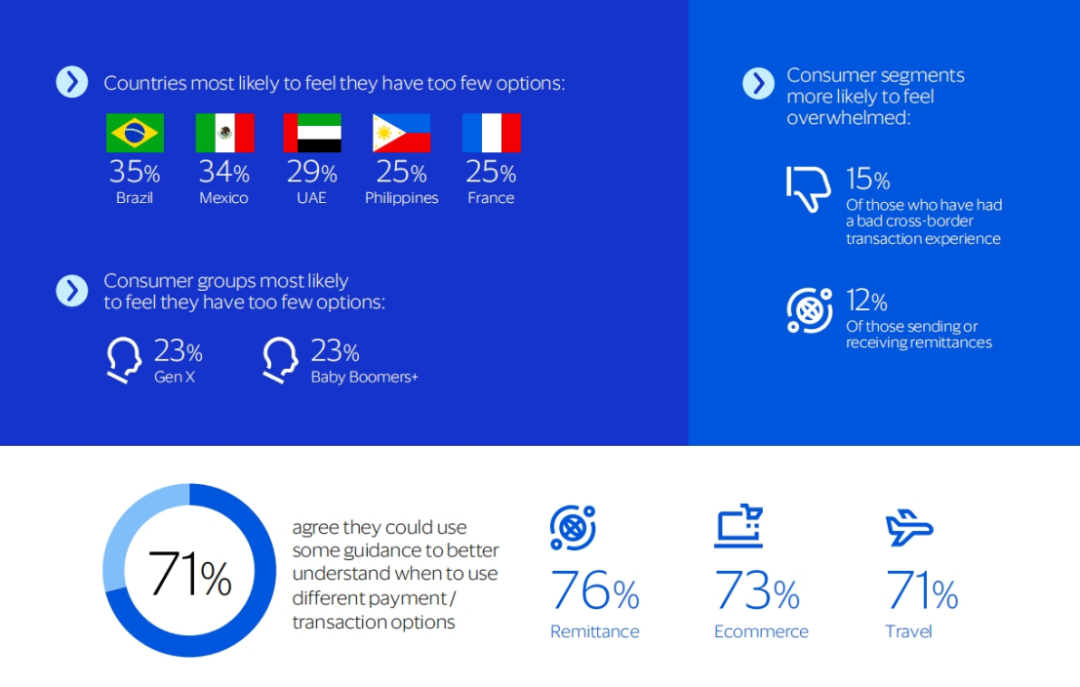
(Unlock the opportunity in cross-border payments, VISA)
Two-thirds of respondents indicated that they prefer to maintain their daily habits, and once they find a suitable payment method, they will stick with it (66%). Meanwhile, three-fifths of respondents stated that they are currently cautious in choosing the tools they use for cross-border transactions (61%).
As people engage in cross-border transactions more frequently, these financial behaviors are gradually becoming habitual. Consumers seek easy-to-use services and clear guidance, and many are also looking for alternative payment options. This is precisely where fintech companies can establish their foothold.
3.4 Security is a Must-Have, Not an Option
For banks and fintech companies, consumer trust in payment security is crucial. Across various regions surveyed by VISA, security consistently ranks as the top factor when choosing cross-border payment solutions. When VISA further analyzed the four most important factors in selecting cross-border payment methods, consumers prioritized security (63%), trust (51%), reliability (49%), and cost (49%).
In all types of cross-border transactions, security remains the primary concern for consumers in all regions, as well as for those participating in travel (63%), e-commerce (62%), and remittance (59%) transactions.
When analyzing the choice of cross-border payment methods, there are also some differences between markets beyond the top three considerations. For consumers in Mexico, Brazil, the Philippines, Hong Kong, the UK, Germany, and Sweden, the accessibility and ease of use of payment methods are very important. In Germany, anonymity is one of the top five factors considered by consumers, while in Brazil, consumers indicated that cost is the second most important consideration after security when choosing cross-border payment methods.
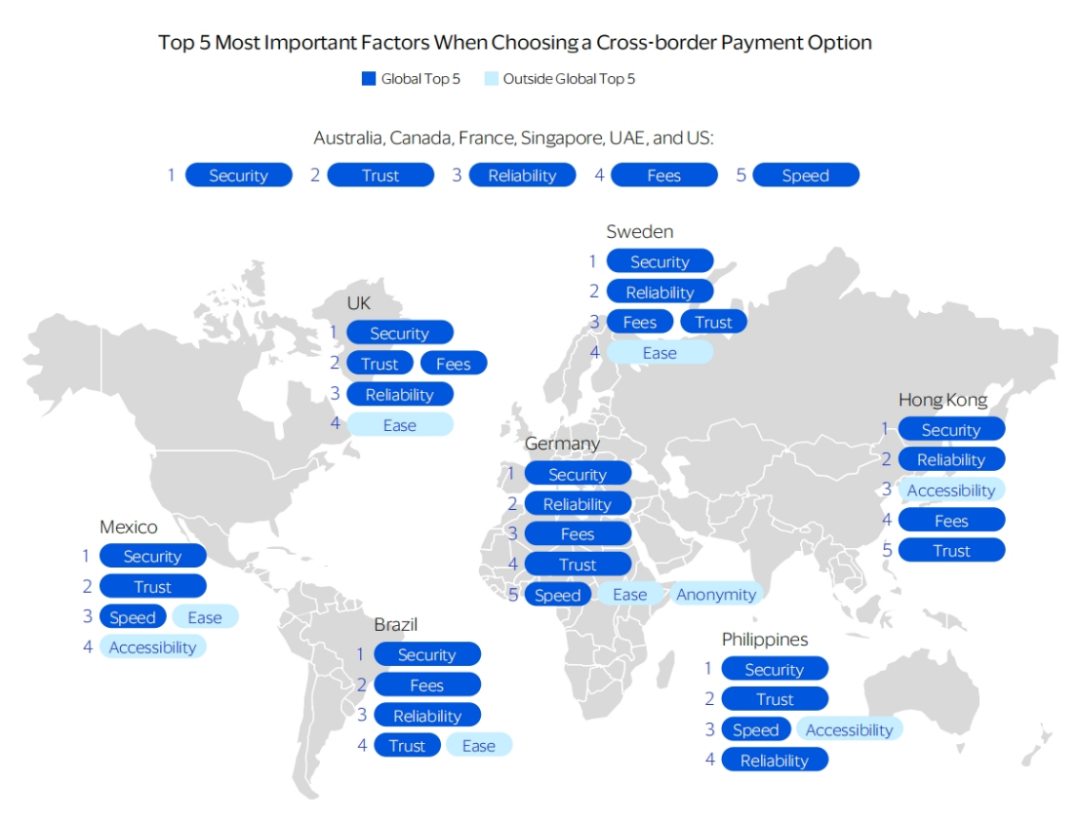
(Unlock the opportunity in cross-border payments, VISA)
Negative experiences that consumers have personally encountered, witnessed, or heard about may be one reason why security is so universally important. Negative experiences can vary widely, including delays, fraud or scams, loss or theft of funds, transaction errors, fee issues, card problems, complex processes, unreliable services, or technical failures. These experiences have profound and serious consequences for those involved.
One in five consumers (21%) has had an unpleasant experience when conducting cross-border transactions. Additionally, consumers engaged in cross-border remittances are more likely to report negative experiences (31%). These groups may be particularly cautious about fraud in cross-border transactions.
A consumer from the UAE described his experience: “…I was sending money to my brother. He urgently needed the funds, but the payment was delayed for a week, and he almost lost his home.” Others reported being double-charged during currency exchanges, encountering fraud, or lacking clear and accessible guidance in obtaining funds. These experiences are highly damaging and cause significant real harm to consumers.
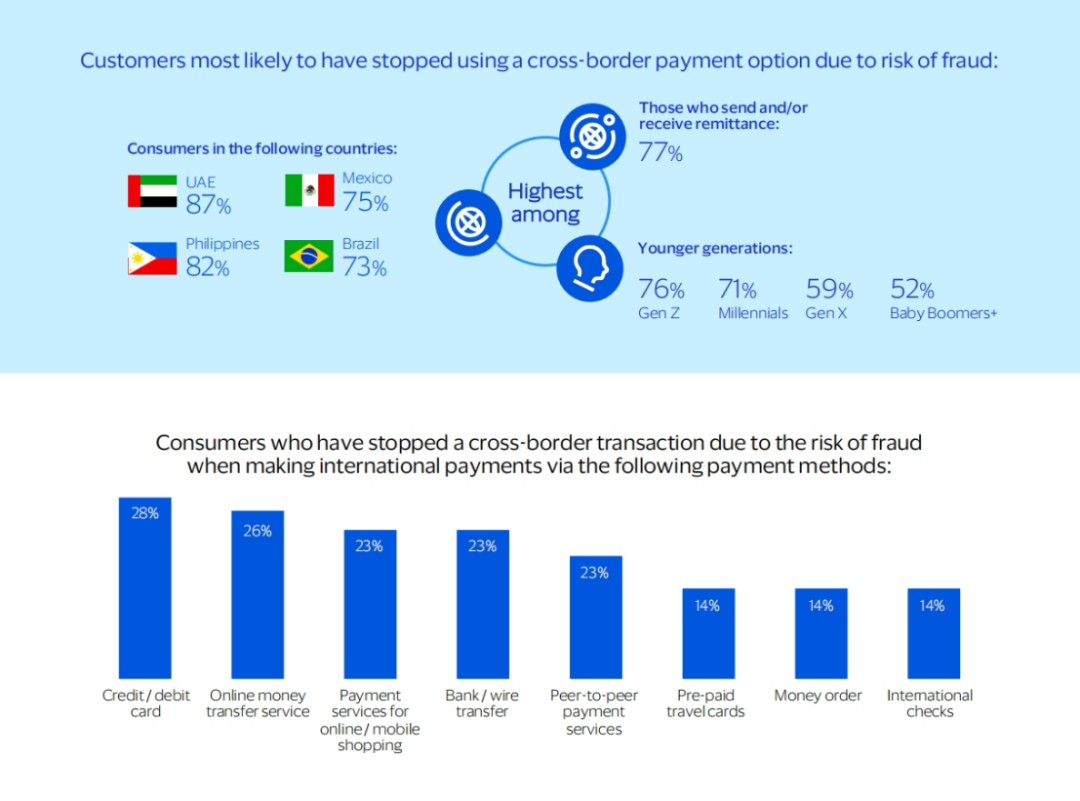
(Unlock the opportunity in cross-border payments, VISA)
Fraud risk is a barrier to using cross-border payments, with a significant proportion of consumers ceasing cross-border transactions due to concerns about fraud risk. Approximately two-thirds of consumers indicated that fraud risk has caused them to abandon a particular cross-border payment method.
Consumers engaged in cross-border remittances, younger generations, and those from the UAE, the Philippines, Mexico, and Brazil are more likely to stop using a payment method due to fraud concerns. Among Generation Z and Millennials, 76% and 71%, respectively, have interrupted transactions due to suspected fraud, while the proportion is 52% among Baby Boomers and older consumers. Traditionally, older generations have established a higher level of trust in traditional banks, while younger generations tend to be more casual in choosing cross-border payment service providers, some of which may be newer market entrants that have not yet built sufficient trust.
IV. VISA's Cross-Border Payment Solution—VISA Direct
With the rise of fintech, the previously bank-dominated money transfer business is no longer limited to specific locations but can occur anywhere with internet access. Historically, cross-border payment methods have been primarily dominated by bank remittances and card payments. As a global leader in digital payment technology, VISA is also exploring how to integrate its existing card organization bank network with digital methods to provide consumers with a more convenient cross-border payment experience—VISA Direct.
4.1 What is VISA Direct?
VISA Direct is a payment platform that enables near real-time domestic and international fund transfers. The platform leverages the processing capabilities of the VISANet global network, allowing payment initiators to securely and conveniently "push" funds directly to the recipient's bank account or VISA card within 30 minutes through acquiring institutions.
Users can use VISA Direct to send money to over 2 billion VISA cardholders and account holders worldwide (Account To Account, A2A), delivering funds to eligible bank cards, deposit accounts, and digital wallets in over 190 countries and regions. VISA Direct supports various use cases, including person-to-person (P2P), business-to-consumer (B2C), and business-to-business (B2B) payments.
The VISA Direct solution is supported by over 500 VISA partners (including acquiring institutions, banks, fintech companies, and other partners). Through this solution, VISA's global customers and partners can connect to VISA Direct via a single access point, pushing payments to eligible VISA cards or accounts for domestic or cross-border payments.
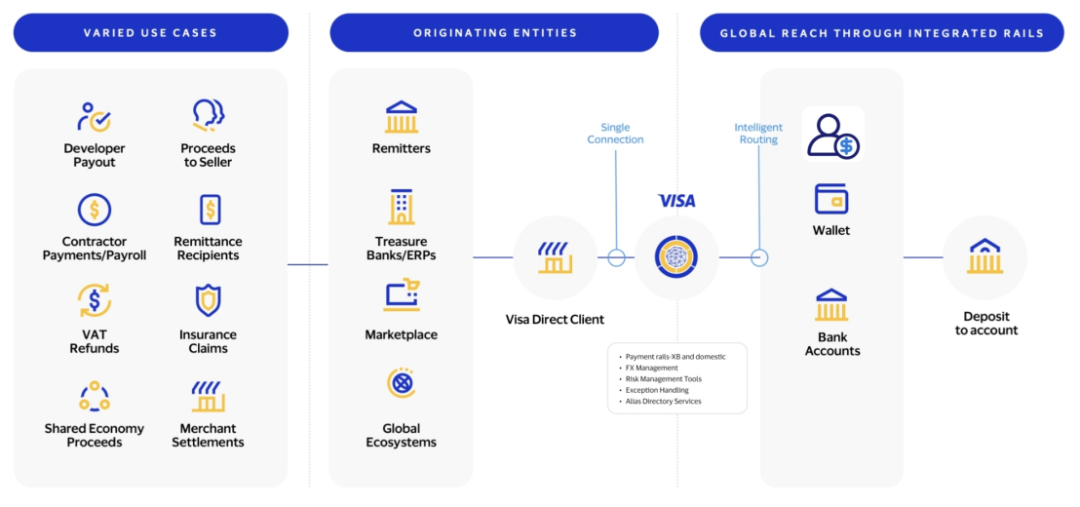
(VISA Direct Account and Wallet)
Although this feature is currently only available for certain VISA cards and acceptance depends on the cooperation of the cardholder's institution, its application scope is continuously expanding. In the fiscal year 2023, VISA Direct processed over 7.5 billion transactions across more than 2,800 projects globally, supporting over 65 use cases. Recently, in March 2025, VISA officials stated that cross-border transactions via VISA Direct grew by 50% year-on-year, while P2P transactions increased by 80%, with an annual compound growth rate of 40%.
In terms of cross-border payments, the core of VISA Direct is: 1) utilizing its established efficient global VISANet card organization network to replace the outdated SWIFT agent bank network system; 2) connecting numerous digital partners through digital VISA APIs; 3) integrating bank account systems and VISA card account systems, providing a one-stop access point.

(Simplify how you send money abroad)
4.2 What Are the Advantages of VISA Direct?
Shirley Yu, President of VISA Greater China, stated: "As a network that aggregates networks, VISA is a driving force in the transformation of cross-border fund flows, connecting the globe through innovative technology. From banks to issuing institutions to fintech companies, various clients can connect to VISA Direct through a single access point, creating cross-border payment tools that provide consumers and businesses with fast, secure, and reliable global fund movement."
This type of real-time cross-border payment holds enormous potential. Data shows that companies using a global real-time payment network for cross-border transactions can increase their transaction volume by approximately 15% annually and enhance profits when entering new markets. Additionally, businesses expect to reduce customer churn rates by up to 60% while improving payment reliability and security.
VISA can provide solutions, and VISA Direct empowers cross-border payments with five key advantages:
A. Global Coverage
VISA Direct offers a single access point, connecting over 8.5 billion endpoints. Its real-time cross-border payment solution allows users to easily access billions of bank cards, network terminals, accounts, and digital wallets worldwide through a single connection.
B. Simplified Compliance
VISA Direct provides compliance support to users through its robust partner ecosystem and VISA Network. As more point-to-point transactions are realized using card-based networks, the payment chain will be significantly simplified when both the sender and recipient use the same bank service; this process will be further optimized when payments are made through digital wallets.
C. Continuous Innovation
With over 60 years of industry experience, VISA Direct is committed to creating future-oriented payment features through innovation, driving continuous advancements in payment technology.
D. Enhanced Transparency
VISA Direct is helping financial institutions and other payment providers improve the transparency of foreign exchange rates. VISA utilizes multiple existing market indicators to generate foreign exchange rates, including data from top market data providers, pricing and liquidity data from foreign exchange trading platforms, and central bank pricing indicators.
E. Cost-Effectiveness
VISA Direct modernizes and upgrades enterprises' cross-border payment capabilities, enabling them to leverage VISA's industry-leading infrastructure without incurring high investments in their own infrastructure.
In an increasingly interconnected global economy, the ability to move funds across borders quickly and securely is crucial. VISA Direct provides a comprehensive solution based on the card organization network, helping businesses simplify cross-border transaction processes, reduce costs, and enhance customer experience.
However, as mentioned earlier, VISA Direct is still an optimization of an outdated system, akin to in-flight refueling rather than venturing into the vastness of space.
V. Solutions for Web3 Payments
Just as the essential attributes of currency (measure of value) and core functions (medium of exchange) remain unchanged despite the evolution through shells, tokens, cash, deposits, electronic money, and stablecoins, the essence of Web3 payments also remains constant—value transfer (Exchange of Value). What needs to change are the service methods of banks, payment institutions, and others; the focus should be on how to provide better financial payment services in a distributed, digital, and transcendent context.
Web3 payments are a new type of payment method based on blockchain technology and digital currencies. Compared to traditional payment systems, Web3 payments have the following characteristics:
- Instant Settlement: Blockchain technology enables instant transaction settlement on a global scale.
- Cost Reduction: By eliminating intermediaries, Web3 payments can significantly lower transaction costs and management fees. Global Accessibility: Anyone with internet access can conduct payment transactions at any time, especially in areas where traditional financial systems cannot reach (Under-banked and Unbanked).
- Decentralization: Web3 payments achieve permissionless access and asset ownership through decentralized finance (DeFi).
- Programmability and Interoperability: By combining smart contract technology, Web3 payments can create more financial derivative services, such as lending and wealth management.
- Enhanced Transparency and Openness: The public and transparent nature of blockchain increases the visibility of fund flows and simplifies cross-border payment processes.
Overall, Web3 payments are not just a new payment method; they also provide a more open, efficient, and innovative financial payment solution through the combination of blockchain technology and digital currencies.
This can be an embedded solution, such as Gate Pay helping to integrate digital currency payment options (Pay with Crypto) into traditional payment gateways, or it can be a cost-reducing and efficiency-enhancing solution based on blockchain and stablecoins, as seen in Stripe's acquisition of Bridge. It can also represent an entirely new innovative financial form based on a blockchain settlement layer, balancing on-chain and off-chain, similar to what MorphPay aims to create with its Morph Black product.
In fact, behind the payment methods, the most significant change brought by Web3 payments is the transformation of the accounting method—the blockchain as a public and transparent global ledger. The current Web3 transformation of the SWIFT network and card organization networks is also a gradual migration to a blockchain settlement network.
5.1 Web3 Transformation of Cross-Border E-Commerce
As previously analyzed, the payment scenario for cross-border e-commerce often involves consumers making purchases in their home country through the payment gateways of overseas e-commerce platforms. For cross-border e-commerce, Web3 payments can intervene in two ways:
- Embedding digital currency payment (Pay With Crypto) options in payment gateways or digital wallets to facilitate consumption for digital currency users;
- Using blockchain as a settlement network to optimize fund settlements between users and merchants, reducing payment processing fees for both parties and enhancing the efficiency of merchants' fund utilization.
While we can see that Web3 payments can indeed bring benefits to cross-border e-commerce payments, a very realistic question, which has been a topic of discussion in the industry, is: how to achieve the mass adoption of cryptocurrencies—how to enable users to hold crypto and how to encourage merchants to accept crypto.
5.1.1 Bridge—The Stablecoin Infrastructure Acquired by Stripe for $1.1 Billion
As one of the three major payment giants in the United States, Stripe acquired the stablecoin infrastructure company Bridge.xyz, which was only two years old, for $1.1 billion in October 2024, creating the largest acquisition deal in the crypto industry. Bridge is a stablecoin API infrastructure that provides software tools to help businesses accept stablecoin payments.
Bridge's main product is the Orchestration API, which integrates stablecoin payments into existing business operations. Once integrated, Bridge handles all compliance, regulatory, and technical complexities.
Through the Orchestration API, combined with Bridge's own offerings of 1) stablecoin cross-chain transactions, 2) fiat/crypto deposit and withdrawal acceptance, and 3) virtual bank accounts, users can transfer funds globally within minutes, seamlessly send stablecoin payments, convert local fiat currency into stablecoins, and provide global consumers and businesses with USD and EUR accounts, allowing users to save and spend in USD and EUR.

(PolyFlow Insights: The Next Step Beyond Stripe & Bridge is PayFi)
For Stripe, one of the largest payment service providers globally, the emergence of Bridge can help implement Stripe's Pay With Crypto strategy, allowing more existing businesses to settle using stablecoins, achieving internal cost reduction and a smooth, seamless user product experience. On the other hand, Stripe can build a stablecoin payment pathway through Bridge that extends beyond its existing banking, card organization, and SWIFT payment systems, while also being compatible with DeFi.
Thus, with the integration of Bridge, Stripe's network effect is no longer limited to its ecosystem but encompasses the entire stablecoin market. Similarly, the PayFi ecosystem built in conjunction with DeFi can break through the geographical limitations of traditional financial services, enabling the free flow of value and financial inclusion for global users. This is also the direction that PayPal, which has issued stablecoins, is striving to achieve.
Bridge's official announcement stated: "The two parties will work together to accelerate the adoption and utility of tokenized dollars, making it easier for everyone in the world to transfer, store, and spend currency. Through numerous practical cases, it has been proven that stablecoins can become the core global fund flow infrastructure, representing a new payment platform. This is not because consumers or businesses inherently want 'cryptocurrency,' but because stablecoins solve critical financial problems."
5.1.2 Gate Pay—Starting with Exchanges to Facilitate Payments
Gate Pay, as an industry-leading B2B cryptocurrency payment solution, provides a one-stop service for cryptocurrency acquiring, issuing, and fiat deposit and withdrawal, while also offering white-label payment gateways and other customized solutions.
In the early development of exchanges, we could see exchanges like Binance, Crypto.com, and Gate.io launching trading loop functions based on their ecosystems, such as Gate.io's Gate Life merchant mall and gift card center (supporting merchant onboarding and allowing users to pay with cryptocurrencies) and Gate.io's Crypto Payment Card. The essence of exchange payment 1.0 is a B2C business, competing for users and meeting the real consumption needs of the exchange's large-scale C-end user base, maintaining user retention, and promoting user activity and loyalty through various incentives.
As the industry has developed, Gate Pay has abstracted the payment capabilities of exchanges into a B2B cryptocurrency payment solution. Any merchant or institution can access all of Gate Pay's product capabilities via API or through a white-label approach. Merchants can customize their front-end and presentation to reach their merchant networks under their own brand. Gate Pay aims to be an infrastructure builder and solution provider that promotes the large-scale application of cryptocurrency payments, whether in the foreground or background.
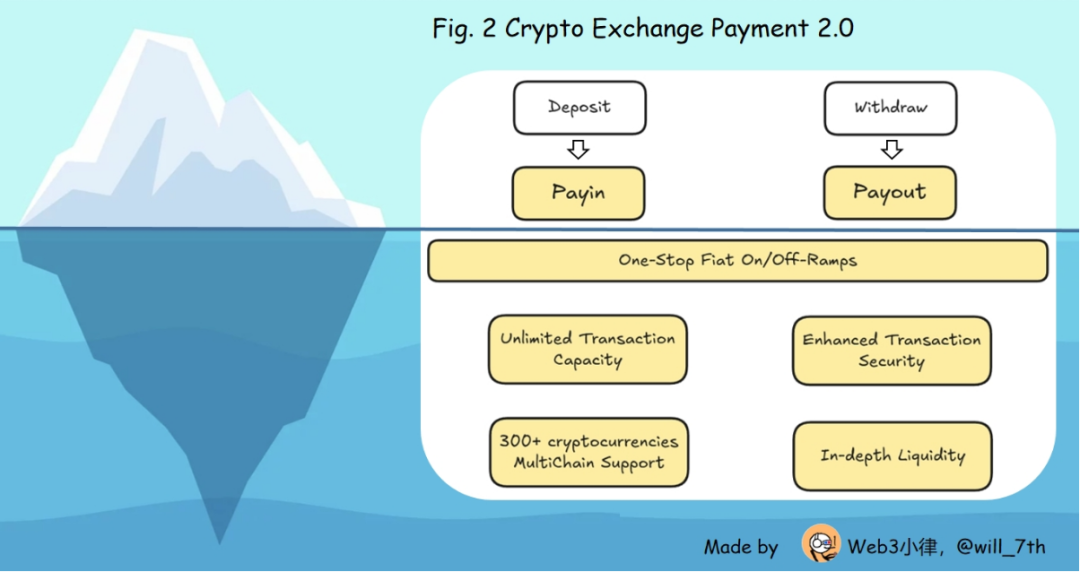
As Gate Pay's head Feng stated: "Exchange payments have evolved from the initial Crypto Payment Card to the internal marketplace of exchanges, and then to generating QR code payments between internal ecosystems. Essentially, these are all B2C businesses, and most exchange payments lack B2B capabilities. In fact, it has been mentioned that the larger purpose of exchange payment 1.0 is to serve the existing users of the exchange, providing user retention and loyalty.
The larger goal of exchange payment 2.0 is to serve users outside the exchange. On one hand, it can leverage the various mature modules already built by the exchange to better expand B2B business; on the other hand, it can also indirectly convert some B2C users, maximizing the advantages of both B2B and B2C."
5.2 Web3 Transformation of Cross-Border Travel
As mentioned earlier, the payment scenario for cross-border travel often involves: offline payments abroad, using debit/credit cards or digital wallet app payment platforms to scan codes. Web3 payments are more embedded within digital wallets, allowing payments to merchants through QR code-like methods. We will first look at the role of Web3 payments from the perspective of an online cross-border travel booking site, and then from the perspective of offline consumption.
5.2.1 Travala—A Leading Cryptocurrency Travel Service Provider
Travala.com is a leading cryptocurrency-native travel booking service provider, offering over 2.2 million properties, covering 230 countries, over 400,000 activities, and more than 600 airlines. Travala.com provides a seamless travel booking experience, integrating next-generation blockchain technology, tokenized incentives, and a "best price guarantee" for accommodations and activities.

(www.travala.com/ava)
In addition to traditional payment methods, Travala.com supports payments in over 100 leading cryptocurrencies, allowing travelers to book using cryptocurrencies and earn up to 10% back in Bitcoin or AVA through the AVA program, along with discounts and AVA token rewards. The AVA program offers discounts and loyalty rewards for eligible bookings made on Travala.com, with greater benefits for members at higher membership levels.
AVA is a loyalty reward token that is more flexible than traditional points. Travelers can use AVA to book future trips on Travala.com, enhance their AVA smart program membership level, or spend AVA on other online platforms that accept AVA.
Travala.com was founded by a group of experienced experts in the travel, fintech, and blockchain industries, with a mission to promote the adoption of cryptocurrency through travel. Travala.com's vision is to combine travel booking with the principles of decentralized technology: promoting accessibility for anyone globally; providing censorship-resistant and peer-to-peer transactions; and creating a user-governed travel ecosystem.
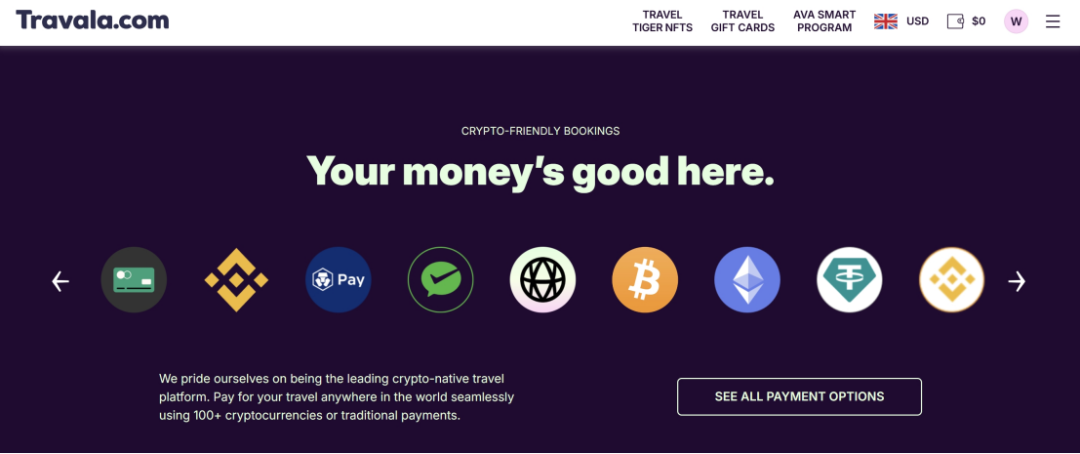
(www.travala.com/ava)
Despite the various missions and visions stated on Travala.com's official website regarding Web3, we can see through the phenomenon to the essence:
- The essence of Travala.com is that it is an OTA travel platform that has added cryptocurrency payment options. After receiving customers' cryptocurrencies, it converts them into fiat currency for settlement with merchants. From this perspective, it merely facilitates the popularization of digital currency payments and connects with the crypto customer base;
- By using cryptocurrencies and settling through blockchain, the platform and merchants can save a significant amount on transaction fees. For example, the standard transaction fee charged by Stripe for fiat payments is 2.9% + $0.30 per transaction, with an additional 1.5% for international cards and 1% for currency conversion. Therefore, the savings on fees can be passed back to users, achieving a "best price guarantee";
- The loyalty program of the travel platform operates through the AVA token economy. Generally, the points in hotel and airline loyalty programs are liabilities for the companies, but the advantage of having a token economy is that it becomes an asset for the company, and the initial cost of acquiring the asset for the project team is "zero." Once the token economy is operational, it can achieve global reach.
5.2.2 Web3 Payments at Corner Cafés
Low-value transactions present a potential opportunity for Web3 payments, especially in low-fraud face-to-face offline transaction scenarios, such as those occurring in restaurants, coffee shops, or corner stores. Due to low profit margins, these businesses are very cost-sensitive, so a 15-cent transaction fee charged by some payment solutions can significantly impact their profitability.
When a customer spends $2 on coffee, only $1.70 to $1.80 goes to the coffee shop, while nearly 15% goes to credit card companies. These high fees are merely to facilitate the transaction, and credit cards serve only the purpose of convenience for the payer.
Neither consumers nor stores need additional features to justify the transaction: consumers do not need fraud protection (they simply receive a cup of coffee) or loans (the coffee costs $2), and the compliance and banking integration needs of coffee shops are limited (they typically use integrated restaurant management software or do not use any at all). Therefore, if there is a cheap and reliable alternative, these merchants will use it.
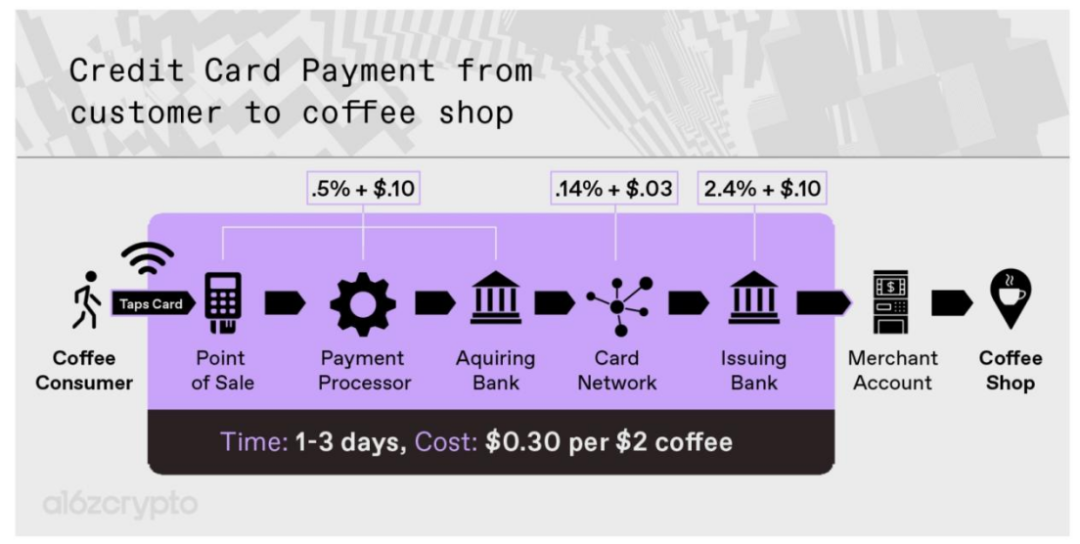
(How stablecoins will eat payments, and what happens next, a16z)
Thus, Web3 payments through QR code scanning can address the aforementioned pain points, allowing for direct settlement through blockchain and stablecoins, leaving behind the high rates of credit cards. Merchants can enjoy greater profit margins and receive payments instantly—what's not to like?
5.3 Web3 Transformation of Cross-Border Remittances
Global remittances are a lifeline for many families around the world. In recent years, although we have seen a wave of new fintech companies dedicated to simplifying digital payments, traditional remittance channels have long been plagued by high fees, slow transfer times, and cumbersome processes.
According to statistics from the International Bank, the average cost of remittances globally accounts for 6.62% of the remittance amount.
Cross-border remittances can take up to five business days to settle. The Bank for International Settlements (BIS) reports that inefficiencies in liquidity lead to delays in clearing and settlement processes, costing the global economy billions of dollars each year.
As a result, many consumers are beginning to turn to cryptocurrencies as a payment option to avoid the pain points of cross-border remittances, such as long processing times and high transfer fees. Research by PYMNTS found that a significant portion of consumers (24%) view the ability to receive funds in cryptocurrency as one of the main motivations for choosing a payment service provider (PSP). For solution providers, there is a tremendous opportunity to offer alternatives to traditional remittance payment methods (such as blockchain payment options).
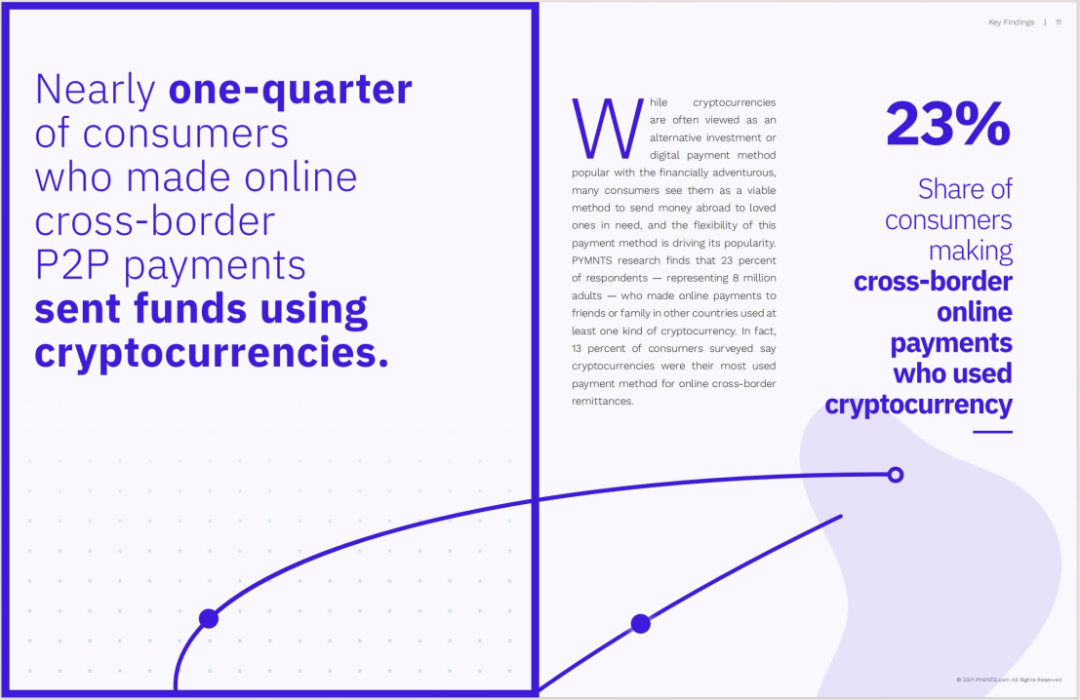
(The Digital Currency Shift: The Cross-Border Remittances Report, PYMNTS)
A 2021 research report by PYMNTS and the Stellar Development Foundation showed that while cryptocurrencies are often viewed as an alternative investment or digital payment method, many consumers consider them a viable option. Among respondents who paid online fees to friends or family in other countries, 23% used at least one cryptocurrency. In fact, 13% of surveyed consumers indicated that cryptocurrency was their most commonly used payment method for online cross-border remittances. The research found that consumers adopting cryptocurrencies also tend to use other cross-border payment transfer methods to eliminate friction in the payment process. Consumers sending cross-border remittances using cryptocurrencies are more likely to send them directly to mobile wallets (46%).
As the cross-border payment market continues to evolve, payment service providers face pressure to reduce remittance costs and address delays. Many consumers remit due to urgent financial needs of friends or family, making them more inclined to choose solutions that can complete payments quickly and securely.
5.3.1 BCRemit—Using USDC to Solve Cross-Border Remittance Barriers for Filipino Workers
BCRemit aims to change this situation for migrant workers, particularly Filipinos working in the UK and the US. By integrating Circle's USDC, BCRemit redefines the remittance experience for its users—making it faster, cheaper, and more convenient than ever, addressing many challenges faced by traditional remittance services and providing users with a more efficient, low-cost remittance experience.
Oliver Calma, the founder of BCRemit, was once an overseas worker himself and understands the high costs and complex processes of traditional remittances. With USDC, BCRemit can facilitate instant transactions 24/7/365, allowing for quick processing of remittances even on weekends and holidays, meeting users' needs for immediate transfers.
Compared to traditional banks and remittance companies, BCRemit's cross-border remittance fees are only 1%, reducing costs by up to 90%, far below the United Nations Sustainable Development Goal of reducing remittance costs to below 3% by 2030.
At the same time, the rapid settlement capability of USDC reduces the amount of capital reserves BCRemit needs for pre-financing accounts in target countries, lowering liquidity constraints and interest expenses, optimizing its working capital, and improving its financial health, allowing it to invest more funds into services and growth.
BCRemit seamlessly integrates USDC into its backend operations, allowing users to remit easily without directly interacting with cryptocurrencies or complex processes. This user-friendly design enables even users with limited technical backgrounds to conveniently use the service.
BCRemit also ensures that even unbanked recipients can easily access funds by providing multiple payment options, including bank account deposits, e-wallet top-ups, and cash withdrawal options at over 17,000 locations in the Philippines, thereby promoting broader financial inclusion. By reducing costs and simplifying the remittance process, BCRemit enables overseas workers to support their families more effectively, improving their quality of life.
5.3.2 MoneyGram—Bridging the "Last Mile"
MoneyGram International has successfully combined digital assets with traditional cash services through its innovative MoneyGram Access™ product, addressing the pain points of delivering digital assets in the "last mile." Supported by the Stellar blockchain, MoneyGram Access leverages the efficiency and low-cost advantages of the Stellar network to provide users with seamless conversion between cash and cryptocurrencies.
Specifically, MoneyGram Access allows users to exchange cash for USDC (a stablecoin) at MoneyGram's global locations, enabling them to use their funds in unprecedented ways while protecting their local currency from depreciation. At the same time, users can quickly and securely send funds to any region globally that supports the service via the blockchain network. Whenever they need physical cash, users can withdraw local currency at participating MoneyGram locations using their USDC, achieving seamless integration between digital assets and the traditional cash economy.
This service is particularly targeted at informal economy participants who lack access to bank accounts or credit cards, allowing them to participate in the storage and transfer of digital assets through cash. Additionally, MoneyGram has partnered with companies like TruBit to further expand its digital asset service coverage. For example, in Latin America, MoneyGram has collaborated with TruBit to introduce MoneyGram Access services in key markets such as Mexico, Argentina, Brazil, and Colombia, meeting the region's demand for efficient cross-border payments.
By integrating Stellar blockchain technology and USDC stablecoin, MoneyGram not only enhances the speed and security of cross-border remittances but also reduces transaction costs, promoting financial inclusion. This innovative model provides a successful example for the global payment industry of how to combine traditional financial services with emerging digital technologies.
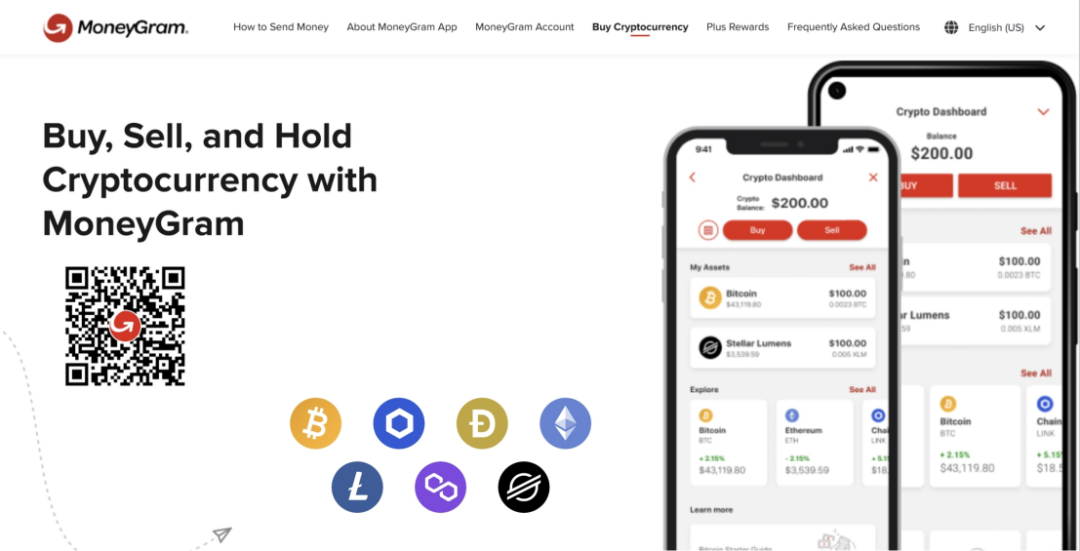
(moneygram.app/buy-cryptocurrency)
The case of BCRemit starts from a single-point scenario (the remittance scene for overseas Filipino workers) and, through the combination of blockchain technology and stablecoins, achieves a significant reduction in user remittance costs while ensuring the timeliness of fund transfers. Although the flow of stablecoins on-chain is already very smooth, there is still a need to bridge the "last mile" from digital currency to fiat currency. BCRemit's solution provides options for bank accounts, e-wallet top-ups, and cash withdrawals at over 17,000 locations in the Philippines, while MoneyGram directly integrates digital currencies into its existing cross-border remittance business, connecting its global network of over 350,000 currency exchange agents.
6. Web3 Payments: More Than Just Payments
Many of the cases discussed above are based on the Web3 transformation of traditional financial payment methods. However, from a broader perspective, can we construct a Web3 payment pathway for consumers through blockchain and digital currencies that exists outside the traditional banking, card organization, and SWIFT payment systems, while also being compatible with DeFi?
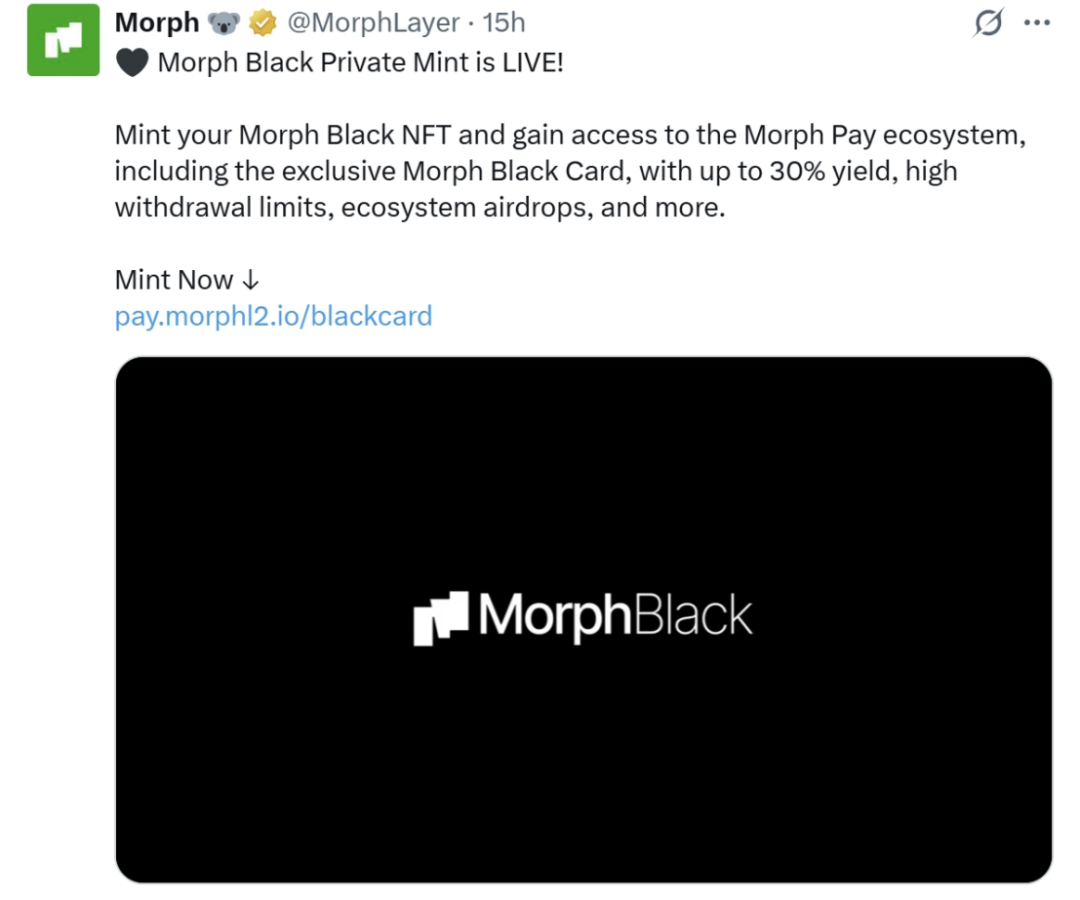
(x.com/MorphLayer)
Morph Pay is leveraging cutting-edge Web3 technology to revolutionize digital payments. We see the direction in the recent launch of Morph Pay's Morph Black, touted as "the first black card for young people," which incorporates multiple solutions essential for consumers in cross-border payments:
A. Blockchain as the settlement layer. Morph Pay utilizes the global consumer-grade public chain Morph, dedicated to promoting the widespread adoption of Web3, as the settlement layer to achieve instant settlement of consumer payments, 24/7/365 availability, low transaction fees, programmability, and interoperability.
B. Compatibility with CeFi. Morph Pay can also provide consumers with convenient conversion from digital currency to fiat currency and flexible banking services through its partnered licensed financial institutions.
C. Consumer payments. Whether the backend connects to VISA/Mastercard debit cards or integrates digital wallet payment scenarios, it can offer consumers a better alternative to outdated payment methods.
The above three points are essential for any Web3 payment solution, but native Web3 payment solutions can offer much more than that:
D. Compatibility with DeFi. As a payment product launched by the consumer-grade public chain Morph, Morph Pay not only creates a one-stop DeFi yield aggregation solution for consumers, supporting annualized returns on crypto asset deposits of up to 30%, but also supports innovative operations of smart contracts, thereby constructing scenarios that traditional financial payments find hard to reach. For example, using DeFi yields directly for daily payments, achieving seamless integration of asset appreciation and payment scenarios, evolving the previous Buy Now Pay Later into Buy Now Pay Never.
E. Ecosystem governance empowerment. On-chain: Users will be able to participate in exclusive ecosystem airdrops and incentive activities provided by Morph and its ecosystem partners; Off-chain: Offering cashback on purchases, Aspire travel concierge services, industry summits, and other benefits to further provide utility for users.
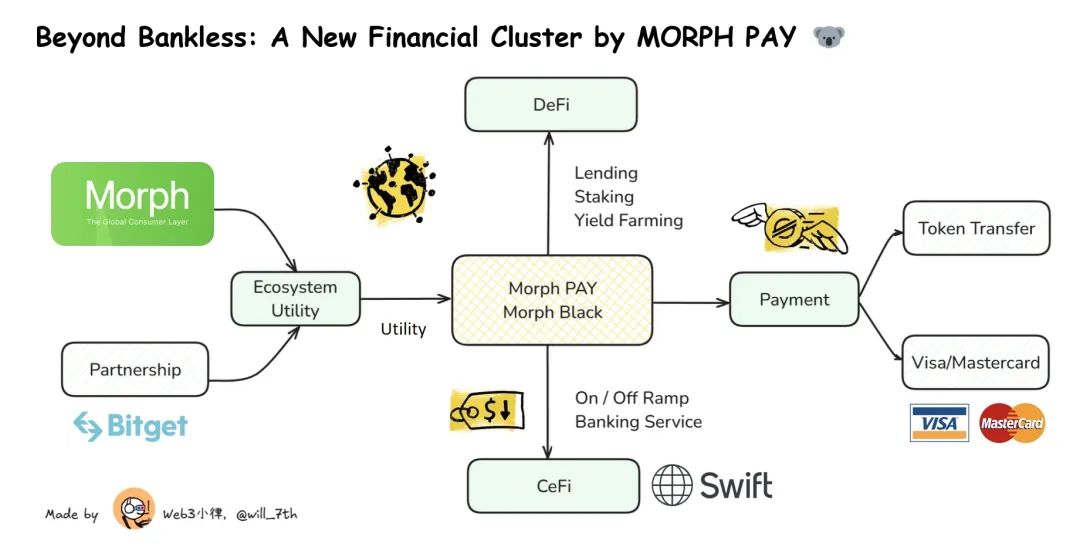
Through the case of Morph Pay, we can see that solutions based on blockchain and digital currencies are no longer limited to a single product and a single scenario. This on-chain composability has already built a new type of financial service complex, encompassing payments, savings and wealth management, lending, remittances, and ecosystem governance. This includes not only digital currencies but also fiat currencies.
Previously, we often said we needed to be bankless, but now it seems we have clearly surpassed the boundaries of being bankless.
7. Final Thoughts
In conclusion, I would like to end with a quote from Gate Pay Feng that I strongly resonate with:
"In the traditional internet space, payments are the most sticky application scenario: not everyone has a brokerage or trading app on their phone, but everyone certainly has multiple payment apps, and this applies to Web3 as well. Currently, the vast majority of Web3 audiences or users are attracted to the trading attributes and profit effects of cryptocurrencies, but even so, the population that owns cryptocurrencies still accounts for less than 5% of all internet users, indicating extremely low penetration. If one day, when the crypto market or Web3 can reach over 90% of internet users, then this scenario will definitely not be DeFi and Crypto Trading, but Payment."
免责声明:本文章仅代表作者个人观点,不代表本平台的立场和观点。本文章仅供信息分享,不构成对任何人的任何投资建议。用户与作者之间的任何争议,与本平台无关。如网页中刊载的文章或图片涉及侵权,请提供相关的权利证明和身份证明发送邮件到support@aicoin.com,本平台相关工作人员将会进行核查。




